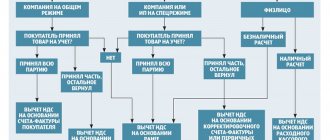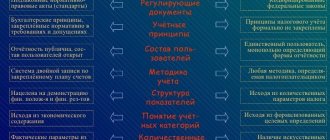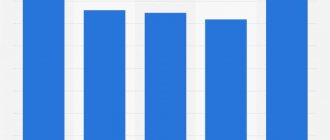Documents for tax refund
The VAT refund is received by the payer of the fee. Can an individual entrepreneur return VAT if he operates on a patent, on UTII, under a simplified scheme or on Unified Agricultural Tax? He cannot do this. It is possible to offset costs by increasing the price of the product or service offered. The main document when paying tax is the invoice. When drawing up and submitting a document to the tax service about the deduction of accrued tax, the required amount of funds is indicated.
How to return VAT for an individual entrepreneur to OSNO? Recovering the tax won't be easy. The inspector checks the documents carefully, so you need to ensure that they are formatted correctly. Compensation for OSNO goes like this: if VAT is negative, this must be reflected in the declaration. After checking the documents, the tax office will determine the validity of the refund.
After 3 months, the businessman can apply for a tax refund. The funds are returned, taking them into account instead of taxes or penalties. If there is no debt, the money can be transferred to the entrepreneur’s current account.
Is it possible to return VAT to an individual entrepreneur before the audit is completed? You can return the money within 10 days after making a positive decision if you submit a declaration, a bank guarantee, or an application for VAT refund to the Federal Tax Service (Article 176 of the Tax Code of the Russian Federation).
Let's sum it up
Individual entrepreneurs and organizations using OSNO can return tax from the budget. Taxpayers under special regimes do not have this right.
To receive money from the Federal Tax Service, you must confirm your right to compensation. To do this, you need to submit a declaration, confirm the right to deduction, confirm the export of products abroad, and prepare an application for return according to the established form (KND 1150058).
Individuals have the right to refund the tax only for goods purchased outside the Russian Federation when they are imported into our country. The list of products and the amount of VAT refund under Tax Free should be clarified in advance.
VAT is one of the most difficult taxes for the common person to understand. Complications arise not only because of the different rates that apply to different types of activities, but also because of the peculiarities of its calculation. In addition, there are options in which VAT can be refunded.
How to return VAT
In what situation does a businessman become entitled to a reduced tax rate?
It could be:
- on a universal basis;
- upon application.
Regardless of the chosen method, tax is refunded:
- to a current account;
- towards future tax payments.
How to return VAT on the purchase of a car as an individual entrepreneur? According to the law, an individual entrepreneur can apply for a refund of part of the money paid when purchasing a car.
To do this you need to provide:
- contract for the purchase of a vehicle,
- invoice;
- invoice;
- payment order to pay an invoice;
- confirmation of vehicle registration.
They confirm that the car was purchased for traveling purposes. For the purchase of a car, you can return VAT by placing the car on the organization’s balance sheet.
As for the acquisition of real estate, an individual can reduce the amount of income tax in the same way as in the case of a purchase and sale transaction for relatives and non-working citizens. The purchase and sale of commercial real estate includes payment of VAT.
When purchasing commercial real estate, the process goes like this:
- invoicing VAT to the buyer;
- he pays the tax to the seller;
- the seller contributes money to the budget.
The interest rate will be 18% based on Article 164 of the Tax Code of the Russian Federation. The buyer is issued an invoice including VAT. And then the difference of the reduced VAT by the amount of the tax deduction is sent to the budget.
On video: VAT in 5 minutes. Basic course. Tax deductions and refunds.
What is VAT refundable?
In some cases, the amount paid for VAT can be returned. This is a very complex issue that causes a lot of conflict situations. We can only say that most of them are resolved in favor of entrepreneurs.
VAT refund is a certain process, the consequence of which is that the taxpayer receives part of the paid tax into his bank account. For legal entities, this becomes possible when at the end of the tax period the amount of VAT is greater than the amount of tax paid to the budget.
But this does not mean that in this case the funds will necessarily be credited back to the taxpayer’s account. To complete this procedure, you will need to perform certain actions.
VAT refund procedure: stages
VAT refund occurs as follows:
- documents are submitted to the Federal Tax Service;
- the fiscal authority checks the papers;
- a decision is made;
- money is returned.
Stage No. 1. If the amount of tax deductions is greater than the VAT payable, a tax refund application is submitted. The following documents will be required:
- Handwritten statement.
- Declaration indicating the amount of return.
Stage No. 2. After submitting the application, tax specialists conduct an audit. At this time, additional documents may be needed: acts, invoices, contracts. If there are no violations, the tax service makes a decision within a week.
Stage No. 3. After receiving the notification, the Federal Tax Service confirms the right to receive a full or partial VAT refund.
Stage No. 4. If a positive decision is made, funds are credited to the company's account. This happens within 24 hours after the decision to return is made.
On video: Calculation of VAT in Kazakhstan
What can guarantee a VAT refund?
Most often, the situation of VAT refund is faced by exporters who apply a 0% rate for export shipments (clause 1 of Article 164, Article 165 of the Tax Code of the Russian Federation) and have the right to deduct the tax paid to suppliers when purchasing goods, works, and services from them related to sales abroad. For them, the question of VAT refund when exporting from Russia, depending on the share of export sales in total sales, may arise quarterly.
Let us immediately note that the mere excess of the amount of deductions over the amount of accrued VAT for the tax period does not yet guarantee a VAT refund. To return VAT, you must go through the procedure established at the legislative level.
A key place in it is occupied by a desk audit conducted by the Federal Tax Service after filing a declaration with the amount of tax to be reimbursed. For this check, the taxpayer is requested to provide a fairly voluminous package of documents, which for the exporter are divided into 2 groups:
- confirming the right to apply a 0% rate on sales;
- justifying the amount of deduction.
What should an individual entrepreneur do on the simplified tax system?
How to return VAT to an individual entrepreneur using the simplified tax system? Businessmen who use the simplified tax system no longer need to pay double tax. VAT is not taken into account if the buyer is invoiced for a product or service. There will be zero tax for the enterprise when the company sells medical goods. This also includes services and work that are important during the football championship next year.
On the simplified tax system, the benefit is retained if the business is related to suburban passenger transportation. A 10% reduction occurs for air transport. This also includes the transfer of livestock or poultry if there is a lease with the right to buy in the future.
The simplified form must indicate:
- who is taking part;
- purpose and terms of the agreement;
- time of completion;
- price;
- on the basis of which VAT is reduced.
What it is
Value added tax (VAT) is a tax that is removed from the price of a certain product, service or work that is created at any stage of the process of manufacturing goods and other things.
It is included in the budget as production progresses. Stage-by-stage content of payment of budget taxes:
- Basic queries.
- Taxpayer Specification.
- State budget reimbursement process.
The tax refund process is described in the Tax Code of the Russian Federation. The tax refund is calculated if the expenditure resources exceed the amount of VAT added according to the tax period.
Taxpayers must charge tax when performing actions that are subject to this tax (including when returning a product to the general tax supplier from an individual entrepreneur or legal entity), issue invoices, record purchases and sales, and draw up a tax return.
And they have the right to use deductions in the amount of tax claimed by suppliers and appearing in a number of individual situations.
It is important to remember that in order for the fact of VAT refund to be detected, you need to go through the entire process, which is established by law.
Special cases of tax refund
Import VAT can be deducted while the businessman is at customs.
For this:
- accept goods for accounting;
- confirm payment of VAT with documents;
- provide a contract and invoice;
- submit a customs declaration on paper or electronically;
- prepare payment documents.
Export VAT is obtained using a zero rate.
To do this you will need:
- prepare documents;
- no later than 6 months after export of the goods, submit a declaration and documents to the Federal Tax Service.
If the contract for services is concluded under leasing, the amount is subject to VAT. An invoice is provided to process tax deductions and refunds. The amount is reflected in the declaration.
How to return VAT to an individual entrepreneur on OSNO illegally taken for 2015? In the fall of 2016, according to the law, an individual entrepreneur on the OSN can reduce income by the amount of expenses incurred by him. Contributions are calculated according to new rules based on Resolution 27-P. This does not apply to the periods 2014 and 2015. An entrepreneur can submit documents to the court.
On video: VAT in Europe
Required documents
In order to receive a refund, or register a VAT rate of 0%, you must submit the following documents to the tax authority for consideration:
- Act on conducting an inspection in an organization.
- A contact made with a counterparty.
- Accompanying documents for the goods.
- Customs declaration.
If goods are exported under a valid agency agreement, you will additionally need to provide an intermediary agreement for verification.
Pros and cons of VAT for individual entrepreneurs
Working with VAT allows you to subsequently issue a deduction. By paying this tax, the supplier will be able to find more serious clients who also pay VAT and receive a deduction, acting as a buyer. Many people believe that it is difficult to achieve VAT payment, since you need to maintain income, expenses, receive an invoice and support it with reporting papers. However, reporting is not difficult. In this case, you can use the services of an accountant. It is important to adhere to deadlines to avoid paying fines later.
Return scheme
What is VAT? How can I return it? To fully understand the entire procedure, the tax refund scheme can be presented in several step-by-step steps.
It should be understood that VAT refund is not an automatic procedure. The interested taxpayer is obliged to independently initiate the procedure for the return of overpaid tax.
How to increase your chances?
It is not at all difficult to collect documents for a VAT refund for legal entities and to follow the rules of procedure, however, in practice, quite often tax specialists do everything to find violations and not issue a refund.
To increase your chances of getting a tax refund, first of all, you should choose decent counterparties and follow the rules for preparing documents, namely:
- keep records of services and goods in all journals provided for by regulatory enactments;
- do not forget to mark the customs clearance;
- check whether all goods are subject to VAT;
- check that all invoices are available and that all goods are included;
- It is mandatory to pay VAT at the border when selling goods outside the country.
Conclusion
The law provides for the possibility of refunding VAT from the budget if deductions for the tax period were greater than accruals.
Before submitting documents for a VAT refund, you must carefully check all the indicators and make sure that your counterparties are “reliable”.
In general, the VAT refund procedure can last from 2.5 to 5 months, depending on the results of the desk audit.
However, in some cases, an expedited procedure is possible - within 15 days.
Requirements for taxpayers when refunding VAT
Before returning money, the payer must familiarize himself with the provisions of the Tax Code. A person on OSN has the right to submit a declaration indicating the amount of the fee to be reimbursed. The main requirement for the payer is to submit the necessary documentation to the fiscal authorities. These include invoices, primary papers, data from purchase and sales books, and other documents.
Fiscal authorities may require supporting documentation not only in relation to transactions, but also for all financial and economic activities of the payer for the reporting period.
Based on the results of the desk audit, the authorities make a decision on refunding the payment, or draw up an act of refusal to refund. There may be a situation where the tax authority partially satisfies the payer’s demands for compensation.
If an organization received a refund based on the results of an audit, however, it was subsequently determined that the receipt was not legal, the enterprise should pay the arrears. You may also be required to pay a penalty if there is a delay.
Reimbursement of the payment is reflected in accounting using entries DT 68 KT 19 - presentation of the fee for refund, or postings DT 68 KT 91, DT 51 KT 68 are used.
Interest for late returns
As noted above, if the tax inspectorate violates the tax refund deadline, it will have to pay the taxpayer interest for each day of delay based on the refinancing rate of the Bank of Russia (clause 10 of Article 176 of the Tax Code of the Russian Federation). From what point such interest should be accrued, we have also already figured out.
However, in practice, the application of this rule often leads to disagreements between tax authorities and taxpayers regarding other nuances of its application. Let's look at the main points related to the calculation of such interest.
Let's start with the interest rate, which is assumed to be equal to the refinancing rate. But in order to correctly calculate the amount of interest, you need to determine the “daily” interest rate, about the rules for calculating which the Tax Code of the Russian Federation does not say anything specifically. The tax authorities are trying to use this circumstance to their advantage, indicating that the Bank of Russia rate must be divided by the number of days in a year (365 or 366). At the same time, they most often refer to clause 3.2.7 of their own Methodological Recommendations for maintaining an information resource of the results of work on offsets and returns (approved by Order of the Federal Tax Service of Russia dated December 25, 2008 N MM-3-1 / [email protected] ), and sometimes also on clause 3.9 of Bank of Russia Regulations dated June 26, 1998 N 39-P “On the procedure for calculating interest on transactions related to the attraction and placement of funds by banks,” according to which exactly this number of days per year is taken into account.
At the same time, if the procedure for calculating the “daily” rate is not provided for by the Tax Code of the Russian Federation, then one should be guided by clause 1 of Art. 11 of the Tax Code of the Russian Federation and use the procedure established for calculating interest for the unlawful use of other people's funds by civil law.
We are talking about Art. 395 of the Civil Code of the Russian Federation. Paragraph 2 of the Resolution of the Plenum of the Supreme Court of the Russian Federation No. 13, the Plenum of the Supreme Arbitration Court of the Russian Federation No. 14 dated October 8, 1998, explains that in this case the annual rate of the Bank of Russia must be divided into 360 days. The majority of arbitrators support this conclusion, pointing out that from a systemic legal analysis of the provisions of the Tax Code of the Russian Federation it follows that the legislator does not envisage the use of a refinancing rate other than 1/360 of the refinancing rate of the Bank of Russia for each day of delay.
This is confirmed by the Resolutions of the Supreme Arbitration Court of the Russian Federation dated October 15, 2009 N VAS-11232/09, dated October 21, 2009 N VAS-13648/09, as well as the Resolutions of the Federal Antimonopoly Service of the Moscow District dated February 16, 2011 N KA-A40/124-11, dated June 1, 2009 N KA-A40/4548-09, dated 05.29.2009 N KA-A40/4573-09, dated 10.16.2009 N KA-A40/10973-09, FAS Volga District dated 03.11.2009 N A65-24431/2008, FAS North Caucasus District dated 08/19/2010 N A53-27429/2009, Federal Antimonopoly Service of the North-Western District dated 10/07/2009 N A52-245/2009, etc.
Another trick of the tax authorities is their attempt to take into account not all days of delay, but only working days, when calculating interest. However, the courts suppress such attempts, pointing out that interest, being compensation for the taxpayer’s losses as a result of a delay in tax refund, is accrued for each calendar day, since from the content of Art. 6.1 of the Tax Code of the Russian Federation (It states that the period determined by days is calculated in working days, if not established in calendar days), it does not follow that when calculating the period of delay in tax refunds, weekends and holidays should be excluded (Resolution of the Federal Antimonopoly Service of the Moscow District dated 14.02. 2011 N KA-A40/342-11, dated 02/04/2011 N KA-A40/18231-10, FAS North-Western District dated 10/24/2005 in case N A56-43355/04).
According to the position of the arbitrators, the period of delay lasts until the day preceding the date of actual transfer by the Federal Treasury authorities of the corresponding amounts to the taxpayer (Resolutions dated December 21, 2004 N 10848/04 and dated November 29, 2005 N 7528/05, FAS Moscow District dated February 16, 2009 N KA-A40 /489-09, FAS Volga District dated December 23, 2008 N A65-5922/2008, FAS North Caucasus District dated November 28, 2008 N F08-6988/2008, FAS Northwestern District dated August 28, 2008 N A05-10302/2007 ).
However, tax authorities often refuse to pay interest for late tax refunds on the grounds that they are not to blame for the delay.
They claim that if they completed their part of the work in a timely manner (made a decision and submitted a return order to the treasury), then they are no longer responsible for the untimely transfer of money by the treasury. However, when considering disagreements between tax authorities and business entities on this issue, arbitrators take a different point of view.
They believe that it is the tax authority, simultaneously with the return of the VAT amount from the budget, that is obliged to ensure the payment of interest to the taxpayer and taxpayers should contact them exclusively with any claims regarding interest (Resolutions of the Federal Antimonopoly Service of the Moscow District of September 19, 2007 N KA-A40/9580-07 and dated December 17, 2007 N KA-A40/13021-07, Federal Antimonopoly Service of the North-Western District dated August 1, 2008 N A56-39965/2007, etc.).
Please note that such interest is accrued only in case of violation of the VAT refund deadlines.
If tax authorities violate the deadlines for crediting VAT at the taxpayer’s request, the interest provided for in paragraph 10 of Art. 176 of the Tax Code of the Russian Federation are not accrued (Resolution of the Presidium of the Supreme Arbitration Court of the Russian Federation dated October 5, 2004 N 5351/04).
At the same time, if the tax authority violates the deadlines established by law for VAT refund, the taxpayer’s subsequent application for offset of disputed amounts does not relieve the inspectorate from the obligation to pay him interest for violating the deadline for refund by offset (see Resolution of the Presidium of the Supreme Arbitration Court of the Russian Federation dated February 27, 2007 N 11484/06 and dated February 27, 2007 N 13584/06).
In conclusion, we note that in order to receive interest for a late tax refund, the taxpayer does not have to write any independent application. Tax authorities must pay such interest themselves simultaneously with the return of the unlawfully detained amount of the tax itself. Although in practice this happens very rarely.
In addition, we recall that interest paid by the tax authority for late VAT refund, in accordance with paragraphs. 12 clause 1 art. 251 of the Tax Code of the Russian Federation are not subject to income tax (Letters of the Ministry of Finance of Russia dated 02/14/2011 N 03-03-06/1/101, dated 03/12/2010 N 03-03-06/1/128).








